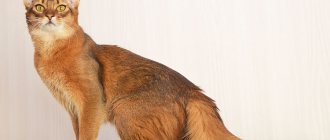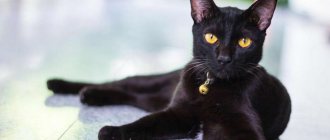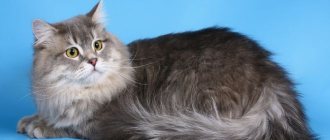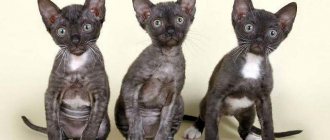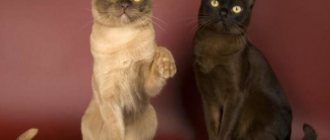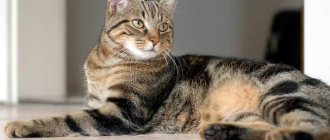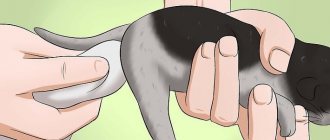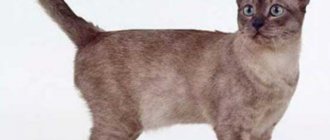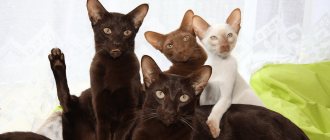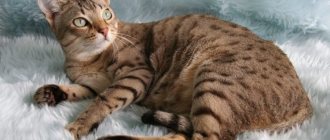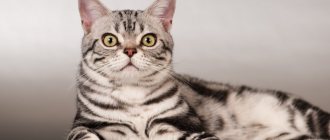Pixiebob is a cat breed that belongs to the category of rare short-tailed cats. The pixie bob, along with the Maine Coon, claims to be a domestic lynx, although these two breeds are not very similar to each other. These cats will appeal to lovers of unusual cats.
The breed was bred in America and officially registered in the 80s. Officially, this is a new breed, but in fact it appeared much earlier than official recognition. Its origin is associated with the crossing of a domestic cat with the North American lynx; it is believed that the appearance of these animals occurred naturally. They lived in the forests, and in 1985, breeders decided to tame these cats and create a new breed. Why were several representatives of pixie bobs caught for the purpose of developing offspring?
The genetic characteristics of the breed were studied in detail in the laboratory, where it was found that wild and domestic cats have a common type, which allowed them to reproduce. In the USA, the pixie-bob cat is very common; Americans consider this breed their heritage. Taking these animals abroad is problematic, as they do not tolerate long journeys well, which can lead to the development of illness and death. These pets received permission to participate in exhibitions only in 1998. But this did not stop them from winning the hearts of cat lovers and gaining popularity.
History of the origin of the breed
Random mutation
One of them says that the ancestor of the breed is the Pixie cat, which had several extra fingers. She gave birth to kittens that inherited their mother's polydactylism, but with a short tail, which they could have inherited from their father.
Another version suggests that short-tailedness is just a random mutation. But no matter which of these versions is correct, pixiebobs outwardly resemble small and gloomy lynxes.
This is a special breed of domestic cat and their name also has an interesting origin. Translated from English, “pixie” is an elf, and “bob” is a short tail. As a result, the pixie bob is a short-tailed elf. The Pixie Bob is not only an interesting polydactyl breed, but a separate group that is characterized by a special genotype.
Breed recognition
This breed was officially recognized in 1995 in the TICA category, and since 1998 they have received the right to take part in TICA championships along with such breeds as Abyssinian, Persian, etc. TICA's priority is pixie-bob cats.
There are few representatives of the breed in the world and there are several reasons for this. The main one is that the Pixiebob breed is considered a national treasure of the United States, so it is not recommended to export it outside the country. In addition, the pixie bob does not tolerate long journeys very well, which is another reason for its non-distribution.
Modern pixiebobs have retained the character traits that were characteristic of their wild ancestors - caution and distrust. They mature late, no more than 3 kittens are born in litters, and only in isolated cases can multiple litters be seen.
At the same time, pixie-bob cats are able to bestow their owners with love and devotion, which can only be compared with the fidelity of a dog.
Mr. Cat warns: the vices, pros and cons of pixiebobs
On average, the lifespan of pixiebobs is about 13-15 years. No diseases characteristic of this breed have been identified. However, diseases of the genitourinary system, as well as cardiomyopathy, characterized by hypertrophy of heart tissue and disruption of its functioning, are quite often observed. Like other pets, pixiebobs are susceptible to various infectious diseases, so do not neglect vaccination and preventive visits to the veterinarian.
There are some defects, the presence of which excludes the pet from participating in championships and exhibitions or deducts points. Signs that reduce the score include:
- the number of toes on the paw is more than seven;
- reduced in size ears or incorrect fit and shape;
- weakly defined chin and brow ridges;
- change in limbs in the form of a cow's posture - curved legs;
- insufficiently light fur on the belly;
- modified profile in the form of a flat forehead;
- thin skin sac on the surface of the abdomen;
- unexpressed arching of the back between the pelvis and shoulder blades;
- narrowed hips;
- tail length less than 5 cm or longer than the hock joint.
The following signs exclude obtaining a title:
- presence of deviations in color, color and hair pattern;
- the presence of a collar;
- round eyes.
Signs the presence of which excludes participation in championships include:
- number of fingers more than 7;
- the tail is long or less than 2.5 cm.
The breed is different:
- simple conditions of detention;
- good health;
- flexible, kind character;
- adaptability;
- friendliness;
- devotion to the owner;
- rare beauty;
- hypoallergenic - veterinarians believe that pixie beans rarely cause allergies in their owners. However, there are also some disadvantages characteristic of pixiebobs. The most significant of them is low fertility. In one litter, a cat usually brings no more than three kittens. In addition, the disadvantages of the breed include its high cost.
general characteristics
There are semi-longhaired and shorthaired pixiebobs.
Character
Their representatives are able to quickly adapt to a new family, becoming affectionate and flexible. They jump, run, play great, love children and quickly find a common language with other pets who live with them. Even though pixiebobs look a little wild, they are actually kind and gentle. They are not afraid of water, open space, or low temperatures. When a pixie bob meets its owner, it makes interesting sounds, something between a chirp and a purr.
A cat of this breed becomes the favorite of the male owner. Most likely, this is due to the fact that its behavior is similar to that of a dog. These cats, like many purebred dogs, are easy to train, and even without much effort, you can teach a cat the simplest commands.
Intellectuals, they are naturally endowed with good memory and intelligence. Thanks to these qualities, they quickly learn the purpose of the tray and scratching post, and once they learn it, they will not deviate from the rules for using them. If you want, you can teach your pix to go to the toilet, and with more diligence, to flush after yourself. The prospect, as you can see, is not bad, considering the benefits of this enterprise - reducing the cost of toilet fillers and saving time on cleaning and disinfecting the tray.
Appearance
Cats of this breed are quite massive and large, with males being much larger than females. Their body has an elongated shape with well-developed muscles and heavy bones. They are characterized by a deep and powerful chest, a slight arch on the back slightly below the shoulders.
Their legs are massive, the forelimbs are slightly shorter than the hind limbs. The paws are large and round in shape. Cats have a short and low-set straight tail, sometimes with a bend. Its length can range from 2.5 to 15 cm. The head is large, elongated, with a rounded forehead and clearly visible brow ridges. A wide and large nose, and in some representatives of the breed it can even be snub-nosed.
The ears are wide at the base, with rounded ends, slightly moved back. Usually you can see dark tufts on the ears, which makes cats look very much like a lynx. The neck of pixiebobs is short and thick. The eyes are almond-shaped and medium in size. Their color can be green, golden yellow or yellow-green. Their fur has a special property - luminescent.
In shorthaired cats, the hair does not lie close to the body and is not dense. The fine undercoat is soft to the touch. Semi-longhaired representatives of the breed have a weakly defined undercoat with medium-density wool. There is no long feather around the neck, and on the cheeks the fur is long and forms a kind of whiskers. The coat color of pixiebobs can be agouti, tabby, or striped.
Description of the Pixiebob breed standards
- the body is medium-sized, closer to large, broad-boned, with a strong chest, the weight of males can reach 10 kg, females - 5 kg;
- the torso is strong and well-developed muscles, there is a pronounced curve on the back, the shoulder blades are clearly visible when walking, the impression of a smooth and powerful gait is created;
- the legs are strong, muscular, the hind legs are more elongated than the front ones, the paws are large, round in shape, there are cats with 6-7 toes;
- the tail is short, no more than 5 cm in length, the ideal tail should be straight, but creases are acceptable;
- the head is pear-shaped, that is, wide at the top and tapering towards the nose, the chin is strong;
- the nose is large, elongated and convex;
- the ears are large, widely spaced, turn outward, and have tufts at the ends;
- the eyes are almond-shaped, widely set and slightly recessed on the muzzle, golden brown or green in color;
- The coat is shaggy and raised above the body, can be either semi-longhaired or shorthaired, and is soft and elastic.
Rules of care and nutrition
Pixie bob cats are easy to care for.
Care
Caring for pixies is not a difficult task, but it still requires some time and attention from the owner. Even the short coat of many representatives of the breed requires weekly brushing, as it is also famous for its thickness and density. As a comb, it is recommended to use a rubber mitten with spikes, a popular furminator to remove excess hair, or an ordinary brush with soft bristles.
All you need to do is take a few minutes to comb their fur, wash their eyes with a moistened cotton pad, and most importantly, do everything to make them feel your love.
There is no need to wash Pixie Bobs often. One bath a month is enough for them. For high-quality washing of fur, it is recommended to use special shampoos for cats.
Pixiebob feels much more comfortable in a private house than in a city apartment - he needs space. The little kittens are fully cared for by their mother. Cats shed 2 times a year – in autumn and spring.
Nutrition
Short-tailed elves are also unpretentious in food - they are equally well suited for dry food and raw meat. The pixie bob can diversify its diet with a caught mouse or bird. The basis of their diet is raw lean meat mixed with porridge. Once a week you can introduce seafood, fish, eggs and cottage cheese into your diet. Be sure to add vitamins, bread and fresh herbs to your food and oil solutions.
Health
Representatives of the Pixiebob breed have not yet been identified as predisposed to severe genetic diseases.
To maintain the health of your pet, he needs to provide:
- proper care;
- balanced diet;
- timely vaccination.
But still, if you become the owner of this rare breed, it is recommended to periodically show the animal to specialists for preventive examination.
Love your gentle and soft friend, and he will delight you for a long time with his devotion and love.
Owner reviews of pixibob
We did some digging on the Internet and collected for you reviews from real owners about animals of this breed. Perhaps they will help you decide whether to buy a pixie bob kitten or take a closer look at other breeds.
Ivan, 34 years old: “My sister gave me a cat when she got a daily job. Neither she nor the poor abandoned animal could stand the new schedule. I had to come to terms with it, not to throw it out onto the street... By occupation, I’m a freelancer, and that’s what my dear Olga appealed to, handing me a wild-looking cat. But as it turned out later, his appearance was deceptive - the cat Arkhip immediately showed sincere friendliness, becoming for me a kind of house elf (which I dreamed of after reading various fantasy stories). Plus, it requires almost no maintenance. I devote almost all my free time to my pet, we watch movies together, play, talk... Eh, I regret one thing: if only he could cook... The best cat for a bachelor is a pixie-bob - I recommend it!”
Natasha, 22 years old: “My favorite cat Ada is a pixie-bob. Soon after her quiet appearance in our house, she created a living hell in it. That’s why I called her this name, derived from the word “hell.” Naturally, I'm exaggerating a little and I'm not angry with her at all. It was even fun, and even now we don’t get bored: the kitty continues to “delight” us with her tricks. She is growing up (she is already 4 years old), but she does not lose her childish spontaneity and playfulness. And it's just great! Sometimes, of course, you want to “kick her” hard, because she rushes around the rooms at breakneck speed, demolishing everything in her path, and even howls periodically, “getting high” from her own madness. But how much I love this “crazy thing” about her; no other cat after Ada will suit me now. It’s fun and great to be with her, and when I’m sad, she lies down next to me, looks into my eyes and understands everything... Kisa listens to me as no one in the world could listen to me. If you get a pixie-bob, you will never regret it, these are the best friends in the world, as loyal as dogs!”
As you can see, pixiebob receives very emotional and enthusiastic reviews. After reading them, you just want to get a sympathetic furry friend. Do not agree? Try re-reading it.
Pixiebob
Nurseries: where are they located?
If you are wondering where to buy a small lynx, don’t worry - there are enough pixie bob nurseries in Russia. For example, in Moscow this breed can be purchased at a nursery called “Wild cat of Moscow”.
But in Ukraine there are no nurseries where specifically pixie bob is bred. The only thing is that in Kyiv professional breeders are engaged in breeding wild cats, including Maine Coons, which look like pixie-bobs.
However, it is not such a rare breed that it is impossible to find. And if you wish, you can always buy a pixie-bob from breeders - specialists in breeding purebred cats.
Also in some of the photos presented are cats from the Russpixi cattery and the breeder of this breed - Alexandra Gats (+79261690484).
Portrait of a typical pixie
The pixie-bob is extremely similar to a lynx: the shape of the head, reminiscent of an inverted pear, and a wide nose, and a strong strong chin, and heavy eyebrows, and small, deep-set eyes with a wild, wary look.
And of course, the pixie's ears are truly lynx-like: far apart, wide at the base and rounded at the tips. Tassels are naturally welcome!
Special signs
Polydactyly occurs in both Pixie Bobs and Maine Coons. Short tails are a feature of many breeds: various bobtails or Manxes. The same Maine Coons, Norwegian Forest Dogs, and American Bobtails look like lynxes. But all three of these signs can only be found in representatives of one breed - pixie-bob.
Voice
It is interesting that even with their “vocal” abilities, squeaky-bobs are similar to wild cats. These big silent creatures, rather, do not meow, but purr loudly or, when played out, growl.
Wool
Pixie bobs can be shorthaired or semi-longhaired. Both have double, fluffy and extremely soft fur; on the belly it is longer than on the back and sides. The long-haired pixie bob boasts an additional decoration - spectacular “sideburns” on the cheeks.
Colors
The color of the pixie-bob is only Brown Spotted Tabby, that is, brown spotted, and the shades can be different. The coat is ticked throughout the body, and in the spot area the ticking is especially pronounced.
Pixie bob kittens
Pixiebob cats do not “complain” about poor health, but 3 cubs in one litter is the limit for them. Moreover, it is not recommended to organize frequent matings. To prevent the pet’s health from deteriorating, it will be enough to mate once a year. Before and after giving birth, the female has time to restore strength and accumulate the necessary vital energy.
At first, the owner does not have to worry about newborn kittens - the mother cat will handle feeding and caring for them herself. Of course, the owner can always take part in the life of the cat family, for example, by changing the bedding in the box and deliciously feeding the newborn pet.
When the kittens get used to lapping from the saucer on their own, they can begin to be given soft food. You can choose either industrial food for kittens or prefer feeding natural products in mashed or crushed form - minced meat, porridge in broth. When choosing the latter option, do not forget to add vitamins for kittens to the food.
You can be sure: a grown-up pixie-bob kitten will thank you for taking care of him. These magnificent animals can be the most loyal and affectionate in the world.
In addition, a mature pixie-bob cat can become a good rodent hunter - its ancestors were wild predators.
Habits and character of pixiebobs
Although the domestic miniature lynx looks like its forest counterpart in appearance, its character is calm and kind. Contact with children is established very quickly, as the animal is affectionate and gentle.
global $ads_google; //data-ad-slot=”2475549904″ $ads_google = empty($ads_google) ? false : true; ?> if ($ads_google == false) {?> $ads_google = true; ?> } ?>
Owners of pixiebobs enthusiastically share reviews about such character traits of their cat as devotion and love for their household. Some even compare the bob-tailed creature to a faithful and devoted dog.
A pleasant feature of cats is their chesty, low-sounding purr.
An owner who wants to take advantage of the natural intelligence of a pet can get involved in upbringing and training: cats perceive commands well and follow them.
The habits of cats are curious: their natural playfulness and affectionate disposition appear only in relation to people. A description of the pixie-bob's character would not be complete without mentioning his ability to get along with other pets: the cat will definitely dominate in such relationships.
